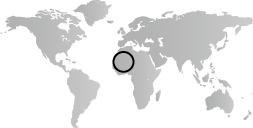The western Sudan is crisscrossed with trade routes linking this interior region of West Africa to the Atlantic coast and ultimately to cities across the Sahara. The western Sudan is the first area of sub-Saharan Africa to be reached by Muslim traders, and the influx of wealth, goods, and cultural and religious influences contributes to the dynamic artistic production. Nok, in the eastern part of the region, is one of the earliest African centers of ironworking and terracotta figure production. Jenne-jeno, populated as early as 250 B.C., is the oldest known city of sub-Saharan Africa. By 850 A.D., it has become a major urban center but is just one of at least twelve sites of comparable size in the middle Niger region. Several other significant political and commercial centers emerge during this period, including Timbuktu, an important site of Islamic religion and scholarship as well as trade.
Western Sudan, 500–1000 A.D.
Timeline
500 A.D.
625 A.D.
625 A.D.
750 A.D.
750 A.D.
875 A.D.
875 A.D.
1000 A.D.
Overview
Key Events
-
ca. 300?–500
The Soninke empire of ancient Ghana gradually emerges as a commercial power, likely consolidating control over already extant local trade patterns. Mastering the new iron technology, the Soninke are ideally placed between the desert—the main source of salt—and the gold fields of the upper Sénégal River.
-
500–850
First occupied as early as 250 B.C., the growth of Jenne-jeno, in the Inland Niger Delta of modern-day southern Mali, proceeds at a rapid pace as the settlement makes the transition from a small, integrated community to a larger cosmopolitan society. This is accompanied and aided by increasing trade and specialization of labor. It is thought that Jenne-jeno had a well-developed iron industry from the time of its first occupation, making it, along with the Nok culture, one of the earliest known Iron Age sites in sub-Saharan Africa.
-
ca. 6th–15th century
Kumbi Saleh, an important political and commercial center of the Ghana empire located in modern-day Mauritania, is occupied. Histories of the western Sudan written by the Moorish nobleman Abu ‘Ubayd al-Bakri (1014-1094)—compiled from reports of Muslim merchants and travelers—document a sizeable Muslim presence in Kumbi Saleh. A stone mosque is built here around the tenth century, one of the earliest to be constructed below the Sahara Desert. In the eleventh century, Kumbi Saleh is described as two separate towns, one distinctly Islamic, containing many mosques. Although considered the permanent capital of the Ghana empire by some, Kumbi Saleh’s significance may have been more intermittent as the locus of political power shifted from one site to another.
-
ca. 7th century
The market town of Audaghost (probably modern Tegdaoust in Mauritania) is established by Berbers as a trading center to compete with the Ghanaian city of Kumbi Saleh.
-
8th–9th century
Islam, introduced to peoples of the Sahara Desert by Muslim traders from the north, gains a foothold in the western Sudan. From this time onward, Islam will make a negotiated, gradual advance within the region and influence a variety of artistic practices. The Islamic community within the Ghana empire, comprised of merchants and traders, is thought to have been substantial.
-
9th century
The Songhai state takes shape, with its capital at Kukiya.
-
10th century
The Kanem kingdom is formed by a number of nomadic pastoralist clans grouped together under the rule of a single dynasty, the Sefawa, a Kanuni-speaking people.
-
10th–15th century
Extraordinary terracottas, mostly depicting human figures in a variety of attitudes, are produced at Jenne-jeno. Amateur and unauthorized excavation has greatly limited our understanding of these figures. Professional archaeological investigation has revealed that they were buried with a variety of utilitarian and ceremonial ceramic objects.
-
1050
Audaghost, an important Berber trading center and rival of Kumbi Saleh, is captured by the Ghana empire. Hostilities inflamed by this act later contribute to a retaliation by the religious sect of Muslim Berbers known as the Almoravids, whose prolonged incursions drain Ghana’s resources and precipitate the empire’s decline. Soon after, the rulers and peoples of Ghana become Muslims.
Citation
“Western Sudan, 500–1000 A.D.” In Heilbrunn Timeline of Art History. New York: The Metropolitan Museum of Art, 2000–. http://www.metmuseum.org/toah/ht/?period=06®ion=afu (October 2001)
Related
Map
